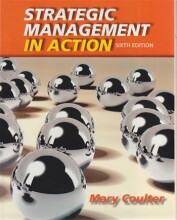Corporate strategies
12 important questions on Corporate strategies
Function corporate strategy?
Growth strategy, what is it
Types org. growth strategies:
- Higher grades + faster learning
- Never study anything twice
- 100% sure, 100% understanding
Advantage and disadvantage of Concentration strategy?
Con: org. vulnerable to industry and external change, risk mitigated by identifying important trends and changing strategic direction
Why is Vertical integration a growth strategy?
Horizontal integration: merger and acquisition
Pro: This growth strategy keeps company in same industry, expand market share, strengthen competitive position
Con: anti-trust laws, org. become so big they can dominate market, risk of price fixing
3 sorts of strategic partnerships
- Joint-venture - two or more org . establish separate independent entity when partners don't want a permanent merger or acquisition (L'oreal and Nestle develop nutritional supplements)
- long-term contracts - a legal contract between org, to share resources, capabilities, core competencies: buy exclusively from the supplier at the assured quality and assured outlet for it products
- strategic alliances - no separate entity created, two org, share resources, capabilities, competencies for business purpose (PepsiCo and Lipton Tea)
Implement growth strategy in three ways
- Merger/acquisition - purchase other org. what is needed. Merger two org. combine operations through exchange of stock or buying expanded product line, market, operations
- Internal development - org, develops new business itself
- Strategic partnership - see above
Evaluating corporate strategies - Measures 1.
Corporate goals measured by earning, revenue, positive image, customer satisfaction, product quality
Efficiency, effectiveness, productivity to evaluate corporate strategy - Measure 2.
Efficiency - org. ability to Minimise Resource use in achieving corporate goals
Effectiveness - ability to reach its goals.
Productivity - how many Inputs produce how many Outputs
Portfolio analysis McKinsey GE stoplight matrix
Con: too subjective analysis because focus on Industry attractiveness and competitive position & too static
Business strength - competitive position (above)
vs Industry Attractiveness - Product-Market (Left)
- Criteria: Relative market share, profit margins
- Ability to compete, Price&Quality
- Knowledge of customer, market, competitive strengths &weakness
- Technological Capability, Quality Management
Product evaluation matrix
Development, Growth, Competitive Shake-out, Maturity, Saturation, Decline
Business units are placed on the matrix according to evalution competitive position and stage product life cycle.
Con: subjective and products don't nicely fit in industry life cycle.
The question on the page originate from the summary of the following study material:
- A unique study and practice tool
- Never study anything twice again
- Get the grades you hope for
- 100% sure, 100% understanding































